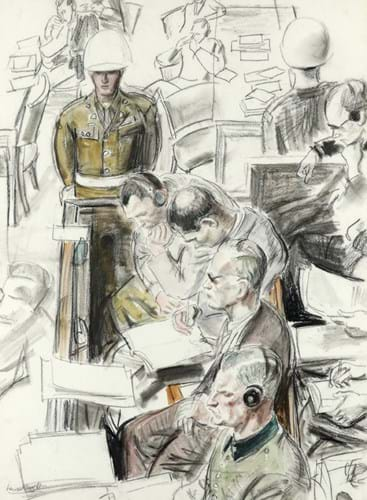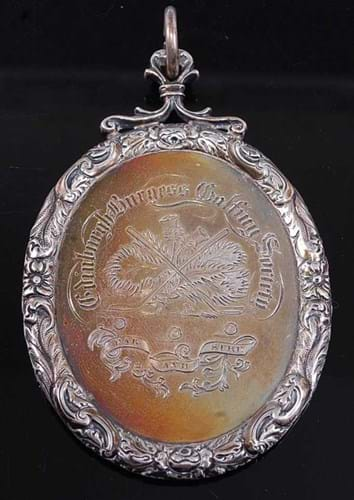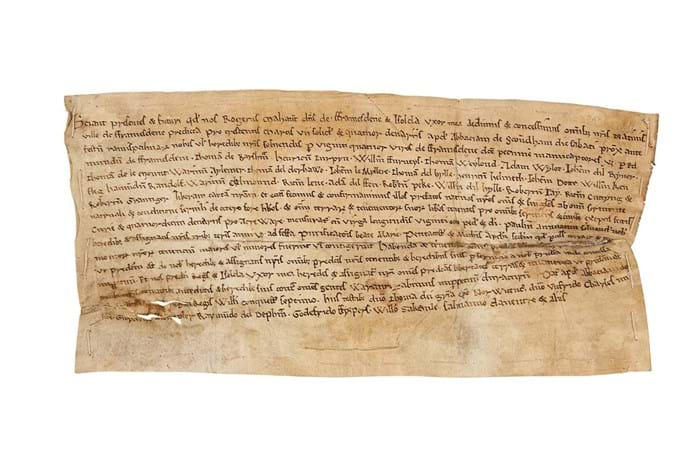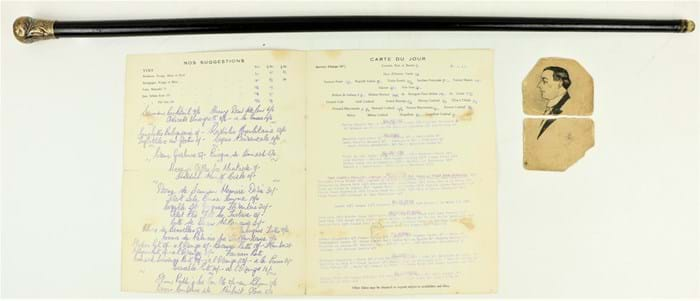
1. Nuremberg Trials sketch
In 1946 the artist Laura Knight (1877-1970) was commissioned by the War Artists’ Advisory Committee to create a painting of the Nuremberg Trials. She spent three months observing the events from inside Courtroom 600 and gained special access to the broadcasting box just above the prisoners, where she was able to make studies of the main protagonists amongst the lawyers and the accused. The finished work, featuring 20 senior Nazis in a courtroom against the backdrop of a ruined city, is on display at the Imperial War Museum.
The picture sale at Woolley & Wallis in Salisbury on December 7 included two of Knight’s sketches for the painting, each measuring 2ft 6in x 22in (76 x 56cm) they were worked in charcoal, coloured chalks and watercolour. They had remained with the artist until 1963 when they entered a private collection: both will now be included in John Croft’s catalogue raisonné.
Because of the subject matter these are important works, offering in colour an eye-witness account of an event now remembered only in grainy black and white film. Seated in the image titled Prisoners in the Dock at the Nuremberg Trial No.1 are Hermann Göring, Rudolf Hess, Joachim von Ribbentrop and Wilhelm Keitel with Karl Dönitz in the row behind. To the other titled Prisoners in the Dock at the Nuremberg Trial No.2 are Alfred Rosenberg, Hans Frank, Wilhelm Frick, Julius Streicher, Walther Funk, Hjalmar Schacht, Franz von Papen, Arthur Seyss-Inquart, Albert Speer, Konstantin von Neurath and Hans Fritzsche.
Determining a commercial value for the two sketches was difficult but, at a time when art relating to the First and Second World Wars is avidly collected, they appeared reasonable at £3000-5000 each. In fact after spirited bidding they took £12,000 and £10,000 respectively.
2. Star Wars poster
Among the unexpected performers at the Prop Store’s entertainment memorabilia sale in Rickmansworth on December 9 was this single sheet Star Wars poster. While the ‘Style C’ artwork by British illustrator Tom Chantrell is instantly recognisable, it is presented here on a scarce Indian 2ft 3in x 3ft 4in (70cm x 1.02m) poster made around the time of the film’s release in the subcontinent on July 1, 1978. Rarer than the equivalent posters made for the US market (Star Wars did not become a phenomenon in India), it was the first of its type the auctioneers had offered. It came for sale from the personal collection of Charles Lippincott (1939-2020), the marketeer best known for promoting and licensing the first part of the Star Wars trilogy. Offered in unrestored condition, with some noticeable wear along the fold lines, it was guided at a nominal £100-150 but took £6000.
3. William IV era golf medals

Silver medal for a tournament held by the Edinburgh Burgess Golfing Society - £3700 at Lacy Scott & Knight.
Perhaps established as early as 1735, the Royal Burgess Golfing Society of Edinburgh holds claim to be the oldest golfing society in the world. Burgess members have played at Barnton since 1894 (and at Musselburgh from 1874) but for its first century and a half, its home was the Bruntsfield Links - one of the earliest known locations where golf played in Scotland.
The sale at Lacy Scott & Knight in Bury St Edmunds included two William IV era medals for competitions held at Bruntsfield Links by the society in 1832 and 1833. Both hallmarked for the Edinburgh silversmith Elder & Co, they were labelled for the Edinburgh Burgess Golfing Society (the royal was not added until 1929) and were engraved with a badge of crossed golf clubs and thistles with the motto Far and Sure. The oval medal was inscribed "Autumn Medal Played For On Bruntsfield Links October 20th 1832 and won by Mr EP Junor while a similar medal of scalloped form was inscribed "Presented for Competition on Bruntsfield Links to the Members of the Edinburgh Burgess Golfing Society by Captain Horn , and won by EP Junor 23d March 1833. Both guided at £300-500 apiece, they took £3300 and £2300 respectively.
4. Medieval forgery

Forgery charter concerning the transfer of land at Framsden in 1073 - £11,000 at Bloomsbury Auctions.
This document is a forgery – a medieval forgery. The single sheet of parchment will 16 lines of Latin purports to be a charter concerning the transfer of land at Framsden, Suffolk, by Roger de Mohaut and his wife Isolde, to their heirs. It is dated to the seventh year of the reign of William the Conqueror or 1073.
However, close analysis of its execution and its content suggest is a fake, probably made in the early 1300s. The writing is a shaky, angular and occasionally clumsy imitation of English Romanesque secretarial hand while it falls down on much factual detail. The creator of this charter did have intimate local knowledge, but it was very much based in the 13th and 14th rather than the 11th century. It references the 'abbey' of Shouldham (here ‘Scoudham’) to the immediate south of Marham, yet the priory at Shouldham was not founded until the 1190s and 'Thomas, bishop of Norwich' as an episcopal witness, although he did not hold the see until 1226. Moreover, while a Roger de Mohaut did indeed hold the estate of Framsden, he did not have a wife named Isolde, and in fact lived in the late 13th century.
So what was the purpose of such an elaborate forgery? It seems likely that the document was created to further the claims of the de Mohaut family to the estate in the 14th century. It does not appear to have been successful. The final piece of the puzzle emerges in the record of a charter of June 4, 1335 (now in the Essex archives), in which Robert de Morlee, 2nd Baron Morley notes that the claims of the de Mohaut family to Framsden had been disputed by none other than Queen Isabel, the mother of Edward III.
The forgery was among further selections from the Schøyen collection offered by Bloomsbury Auctions in London on December 7. In English antiquarian ownership in the19th-century, it had been acquired by Norwegian businessman and collector Martin Schøyen, as a good example of medieval forgery, from dealer Sam Fogg in December 1989. Estimated at £3000-5000, it sold at £11,000.
5. Michael Collins cane

Walking cane given by Michael Collins to a barman who refused to blow his cover - €15,000 (£13,600) at Fonsie Mealy.
This late 19th century walking cane with sturdy ebonised shaft and silver-plated handle comes with a letter of provenance stating that it had been a gift from Irish revolutionary soldier and politician Michael Collins (1890-1922) to Patrick Baker, one time head barman at the Gresham Hotel in Dublin. It came by descent for sale at Castlecomer saleroom Fonsie Mealy in Stillorgan, Dublin on December 7.
This stick, sturdy enough to be used as a cudgel, was carried by 'The Big Fellow' in his efforts to blend in with the gentlemen that frequented the Gresham during the War of Independence. Collins was engaged in a guerrilla fight against British forces, planning and directing many successful attacks including the Bloody Sunday assassinations of key British intelligence agents in November 1920.
According to the letter penned by Baker’s granddaughter, the cane was given as token of gratitude after Baker had ‘failed’ to identify Collins to British agents who came to the Gresham to find him just before Christmas that year. “When my grandfather was asked by British agents if he had seen General Collins, he had to keep a very cool head. Collins was directly in front of him at the bar, standing right beside the British and even asked them to join him for a drink.”
A modest item with a powerful story, it raised plenty of interest at its €3000-5000 estimate before selling at €15,000 (£13,600).






